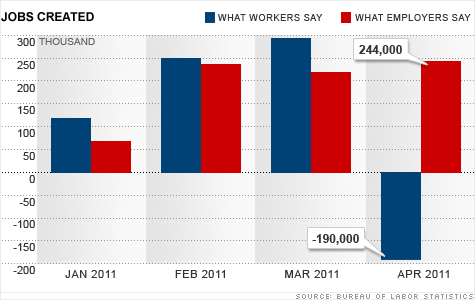Search News

NEW YORK (CNNMoney) -- American employers and workers are still not seeing eye to eye on the job market.
The government's highly anticipated April jobs report showed somewhat of a paradox Friday. Employers claim they added 244,000 jobs in April, but workers say they lost 190,000, pushing the unemployment rate up to 9%, from 8.8%.
"We're still in this zone where we don't have these two surveys agreeing," said Heidi Shierholz, economist for the Economic Policy Institute. "Was April positive or negative? Our two major surveys don't agree on that simple fact."
So why the disparity?
The Labor Department compiles the jobs report based on two separate surveys. The first survey collects business and government payroll data. The second -- which is used to calculate the unemployment rate -- surveys American households.
The two don't always move in lock step. Economists prefer to focus on the payrolls data because it's less volatile and has a larger sample size.
But most people agree that a 9% unemployment rate is still too high.
Two major trends pushed the unemployment rate higher to 9% in April.
The good news is that 113,000 people who had previously given up hope, started looking for jobs again, boosting the number of people counted as unemployed. These new applicants signal confidence in the economy, but the downside they also help push the unemployment rate higher.
The bad news is that another 190,000 Americans also claimed they lost their jobs -- and economists are generally unclear of why this happened.
"Other than month-to-month volatility, there are no underlying economic fundamentals that would explain that big of a drop," Shierholz said.
So while employers said that they hired in April, workers reported that they still lost jobs.
Some economists shrugged off the 190,000 drop, claiming the household survey is generally more volatile and less accurate than the payroll survey. Others claim that the one-month weakness comes after several robust months from the same report -- so the overall trend is still strong.
Just last month, American workers reported they had gained 291,000 jobs, and in February, they said they had gained 250,000.
"If you average out the data, you pretty much get the message -- we're seeing a strengthening trend in job growth this year," said Sal Guatieri, senior economist with BMO Capital Markets.
Guatieri also points out the unemployment rate may merely be in for a slight correction. When it fell a full percentage point between November and March, it seemed too good to be true -- and perhaps it was.
"I think some back-up in the unemployment rate was anticipated," he said.
Still, the unemployment rate is down significantly from its 9.8% level in November, and that's a sign of gradual improvement, he said.
As the recovery remains on shaky ground, economists aren't expecting the mixed messages about jobs to end just yet.
"These weird months just continue to show we're in a rocky recovery," Shierholz said. "What we really need to be seeing is month after month of really strong numbers across the board. That's the kind of data I would want for the 14 million unemployed workers in this country." ![]()
| Latest Report | Next Update |
|---|---|
| Home prices | Aug 28 |
| Consumer confidence | Aug 28 |
| GDP | Aug 29 |
| Manufacturing (ISM) | Sept 4 |
| Jobs | Sept 7 |
| Inflation (CPI) | Sept 14 |
| Retail sales | Sept 14 |